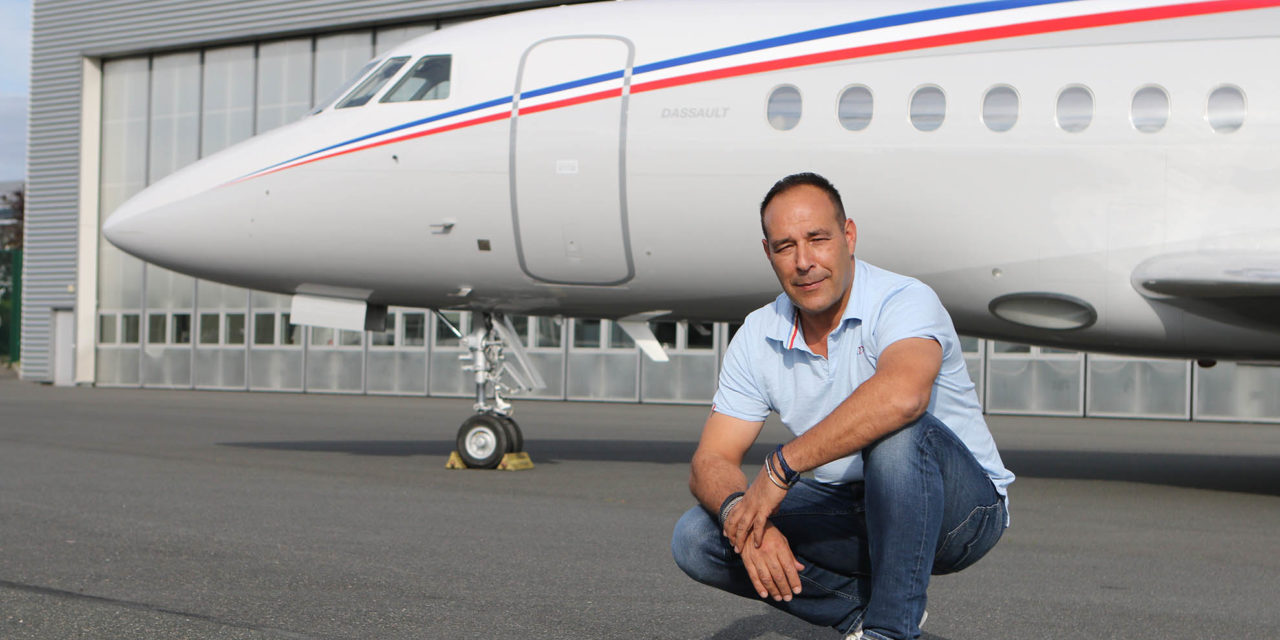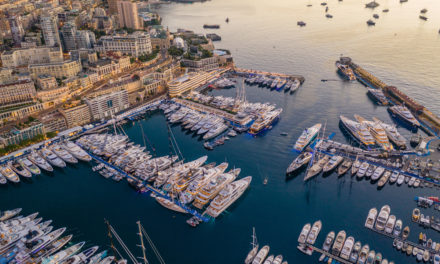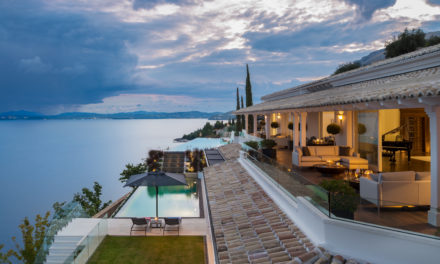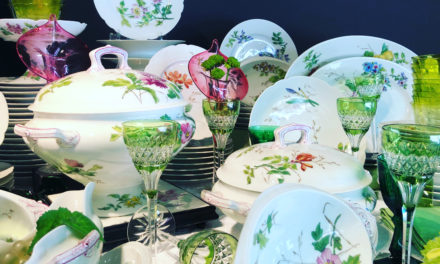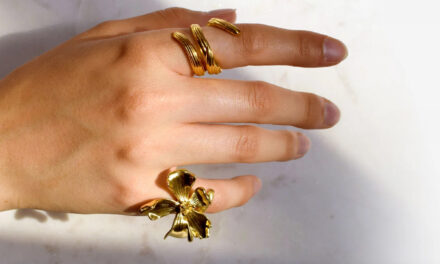New converted try for Happy Design Studio and its founder, Didier Wolff, who expressed all his talent on the curves of a Falcon 900. Known as Thermidor, this new livery brings together French skill and know-how.
Back on a particularly demanding project.
Olivier Dassault, owner of the trijet, symbolizes and promotes this ingenious France. The man, in turn political, entrepreneur, pilot and appreciably artist is not in his first cooperation with Didier Wolff. Indeed, Marcel Dassault’s favorite grandson had already asked Happy Design Studio to produce the livery for his former Falcon 10 in 2011. Almost ten years after this first experience, Olivier Dassault wished that the Strasbourg designer draws the livery of his new business jet, a livery outside the norms, probably summarizing a more personal part of his multifaceted life.
At the crossroads
It is in this context that Didier Wolff drew the first sketches of this resolutely “Frenchy” design. Working with a man like Olivier Dassault undoubtedly remains an experience apart, and the values he vigorously defends must have found their place as naturally as possible on this giant canvas. For his first draft, Didier Wolff “insisted to put blue, white and red references on this plane” by explaining that this project was “literally at the crossroads of business aviation and military aviation, but also a bearer of Olivier’s values” before adding:” The finalized design reflects fully the ideal vision I had of this project “. The paint scheme borrows the variations of gray used on the Rafales or the Mirages. Some typographical notes and clues evoke the name Dassault historically linked to the military universe, the tricolor bands obviously referring to the French Republic and the mandate of the elected official. “Like a work, the paint scheme imposes a sense of reading from the front of the plane, clearer, towards the rear, in other words from business aviation to military aviation, the two universes being thus linked by a deliberately smooth transition”, underlines Didier Wolff.
” To face “
This decoration carries in itself a number of symbols, “I worked on it just as if I worked on the French Republic Falcon, as their characteristics are close”. It is the culmination of long hours of reflection and the fruit of a compilation of half a dozen projects submitted to the owner. “Even if Olivier did not give me any particular instructions, he validated a very intuitively designed project in which he simply recognized himself. Although he hesitated between two other more neo-retro proposals, the Thermidor livery imposed itself naturally “notes the designer before adding:” Once again, be attentive to the clues sown by my clients remains the common thread in the creation of my works. It’s a fairly long process, driven by curiosity and information-seeking. Without this approach, customizing the livery is meaningless. ”
Didier Wolff took up the idea of rings surrounding the air intake of the engine nacelles. “This is an option that I love and that has been in my drawers for years because it gives a lot of personality to an aircraft. Like rings encircling the front of the engines, these rings are perfect for hosting a name, a mention. ” insists Didier Wolff who inscribes “To face”, the motto of the French Air Force Academy from which Olivier Dassault comes.
Like the engine nacelles, each detail comes together logically like the elements of a giant puzzle: “The original livery was slightly more contrasted. So, I chose to lighten the colors so that the inscriptions are visible without imposing. ” Only the three-color bands extracted from the color spectrum were produced with the exact colors of the French flag, including a reference of perfectly pure white, unique in the color charts available in aeronautics. “The other important aspect for me was the lateral perception of blue, white and red. When we see the plane in profile, the three-color stripes seem perfectly balanced in terms of their dimensions, as if each was the replica of the other. ” emphasizes the designer.
But this step, which was also a technical feat (and physical during masking), alone required several hours of millimeter adjustments in order to play in trompe-l’oeil with the fuselage curves so that none of the three shades does dominate the set. This work on the colors was demanding, as was the livery design: “In order to affirm the Dassault lineage, I diverted the movement characteristic of the aircraft manufacturer’s official livery on the Falcon range to that the aircraft has a certain momentum. This approach complicated the implementation of the long dark gray curve that runs throughout the fuselage because it was done by hand and without stencil. It was through patience and observation that I found the right dosage so that the curve naturally tapered towards the front cone and narrowed to the extreme. ” The same technique was used on the winglets, “which despite their very complex shapes were easier to hide thanks to their human size”, concludes Didier Wolff. In addition to applying the paint and finishing work, Didier Wolff would also like to salute the performance of the teams at the painting workshop, who carried out “an exceptional work of preparation especially by sanding each layer in order to smooth out the staircase effect ”. Hardly visible at first sight and with no notable impact on aerodynamics, this effect which is however noticeable to the touch, has been completely annihilated by successive sanding and buffing, giving the aircraft an extremely smooth finish whatever the painted areas.
Eleventh french republican calendar month
This livery was developed in a few months using 3D software during the summer of 2019. After a stay for scheduled maintenance at Dassault Falcon Service (DFS) at Le Bourget airport, the Falcon 900EX joined the Satys paint shops close to DFS.
The painting job having taken place during the summer, Didier Wolff had the idea of baptizing his livery “Thermidor”, in reference to the eleventh month of the French republican calendar, which ran from July 19 to August 17.
The scorching summer of 2019 was an additional constraint, forcing the painters to adapt their planning daily. “The chemical reaction of paints and varnishes at high temperatures required working at night or very early in the morning when the air was coolest” explains Didier Wolff who admits “to have been fortunate to be assisted by teams listening to him “.
It is true that the prestigious nature of this complex project has stimulated and valued the recognized competence of the contributors, DFS for maintenance, Satys for painting and Jet Eval, the aircraft manager acting on behalf of the owner. According to the artist “All have greatly contributed to surpassing current standards and highlighted a know-how often abandoned today in favor of a certain yield”.
On this project “even the hidden or barely visible parts of the aircraft have been particularly cared for” insists Didier Wolff. In total, the Thermidor project has required approximately 2,600 work hours and more than 300 liters of paint and varnish have been used.
This unique experience also allowed the designer, for the first time in his career, he said, to be invited to fly aboard the plane “customized” by himself, to go and attend the reception of the aircraft by Olivier Dassault. “It was an intense and exceptional moment to observe the reaction of the owner discovering for the first time the exterior decoration of his aircraft.”
In addition to this unforgettable moment, the Thermidor concept has also allowed the founder of Happy Design Studio to be admitted to the very closed community of “Peintres de l’Air” (Air painters).
This is the first time in its history that this prestigious French Air Force institution welcomes a designer.

